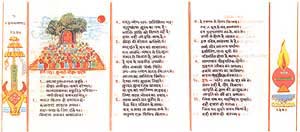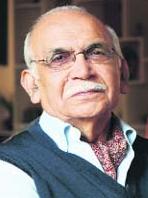I wonder if anyone else has noticed this, but I seem to keep returning to Jain themes in this column. It has little to do with my own respect for the faith - the more I see of it, and read about it, I should mention, the more I am struck by some of the things in it - it is more a case of some compelling thing or the other that one comes upon. There is, for instance, this ongoing and fairly large exhibition on Jainism in the Chandigarh Museum, mounted with some care, some feeling, with major participation from a Jain institution in this region.
It is a bit of a mix of this and that - some fine pieces and information panels, and some quite ordinary things, more didactic than visually exciting - but all the same it makes an impact. The show-cases with the objects that Jaina munis or sadhavis carry with them as they move about the countryside, the small portable shrines, or the instruments used to write sacred manuscripts with, all look splendid. On the other hand, the rather routine-looking Kalpasutra folios, the sculptural fragments from Murti, and the occasional contemporary work, offer little visual excitement. So, as I said, all in all a mixed bag, but something that many more people than one sees in the galleries now, need to see it. For there is much for everyone to learn about one of the most ancient, certainly the most ascetic, and the most self-denying, religions of mankind.

Folio from a manuscript of the Rishabhayana. Illustration by Manju Nahata, 1998.
By pure coincidence, just a few days after I had seen the show in the Chandigarh Museum, I met a young painter, Manju Nahata, who was attending a workshop that I was conducting in the eastern region, on the act of viewing: ‘Looking’ at works of art, in other words. She was an eager participant, deeply interested in what I was talking about, or discussing; but also deeply interested in showing me the work that she herself was doing. Despite some problems with my schedule, I did make the time to go and see her work. She was a practising Jain, I found out, as was her husband, and what interested her most was to present Jain thought and philosophy in visual terms. There is nothing new in this, one would have thought, for Jain art is rich as it is in images that are abstract and diagrammatic and powered by symbolism. But what Manju Nahata had set out to do was something slightly different. All the 24 Tirthankaras those great Saviours - literally, those who can take one ‘across the ford’ - she wanted to understand and interpret in her paintings. This in itself is an enterprise, for in traditional Jain paintings, it is generally only four of them who receive detailed attention, and even in these, it is familiar, sometimes recurring, episodes from their earthly lives that form the subject of visual rendering. And then, Manju wished to engage herself equally with the lives of each one of them, and of course with their teachings, drawing their essence in her own, visual language. There were 24 panels, therefore, that she had painted, one devoted to each of the Tirthankaras, and each she had titled using pairs of words, sometimes complementary, sometimes contradictory. Thus: Adi-Anadi; Mati-Sumati; Jada-Chetana; Dhyeya-Shreya; and so on. It was absorbing, the experience made the more so by the intensity with which Manju spoke of them. It was obvious that she was steeped in Jain lore, and involved in Jain thought. Talk of Arhats and Acharyas, Upadhyayas and Munis, seemed to come so naturally to her, for she knew something of them from close.
The work was of a mixed kind, I should add: some panels were completely abstract, others constituted a throwback to the stylised Bengal school manner; still others were very narrative in approach, depending more upon her verbal ‘explanations’ of them than upon the strength of her visual language. But, as I said, it was absorbing. Then, as she was finishing, she showed me a folio from a work which her preceptor, Muni Sumermal, had been writing in his hand, in the highly calligraphic manner of time-honoured manuscripts, and which she was illustrating in her own style. Suddenly, it appeared as if the tradition of writing works in one’s hand - something that so distinguishes the Jain faith, for in it the writing of manuscripts and presenting them to a bhandara earns for one great spiritual merit - had not quite died out. Yet.
In the process of seeing all this work, and reading the little introduction to it that she had written, I picked up some facts, some insights. Certainly something of Jain lore that the paintings drew so heavily upon. The 14 auspicious dreams dreamt by the mother of the Tirthankara-to-be I already knew something about, as I did the eight pratiharyas. But I did not know that Rishabhanatha, the first of the Tirthankaras, is believed to have gone without food for a whole year, and broke his fast only when his own grandson offered him a pitcher of sugarcane juice. Or that during his long penance of 12 years, Mahavira, the last of the Tirthankaras, and a historical figure, is believed to have taken food only for 349 days. The turning back of Neminath at the sight of animals about to be slaughtered in celebration of his marriage, and his consequent renunciation, and the saving by Parshvanath of a serpent pair from being consumed in the sacrificial fire lit by a sadhu, are things that I had read about earlier. But I did not know how often the theme of the world suddenly becoming a calmer place the moment a Tirthankara was conceived by his mother, reoccurs in Jain tales. Or that Mallikumari, the 19th Tirthankara, was a woman. This last bit I would like to read a little more on.
Unusual images
This does not follow from what I have been saying earlier, but I am tempted to bring in a reference to one of my great favourites among all of Indian sculpture. It is a thick sheet of brass from which the figure of a Tirthankara, standing in an erect posture of penance, is cut out. So that one does not see the figure: one only sees its outline, a negative space, if one so likes. The thought that it interprets apparently is that through discipline, and penance, it is possible to make one’s body so sukshma, so unburdened by matter, that wind can pass through it unhindered. It is a moving image, brilliantly conceived, handsomely executed. I had heard it being described as a siddha-pratima, but a friend told me the other day that it is also sometimes referred to as an akash-murti. How wonderfully appropriate!
 B.N. Goswamy
B.N. Goswamy